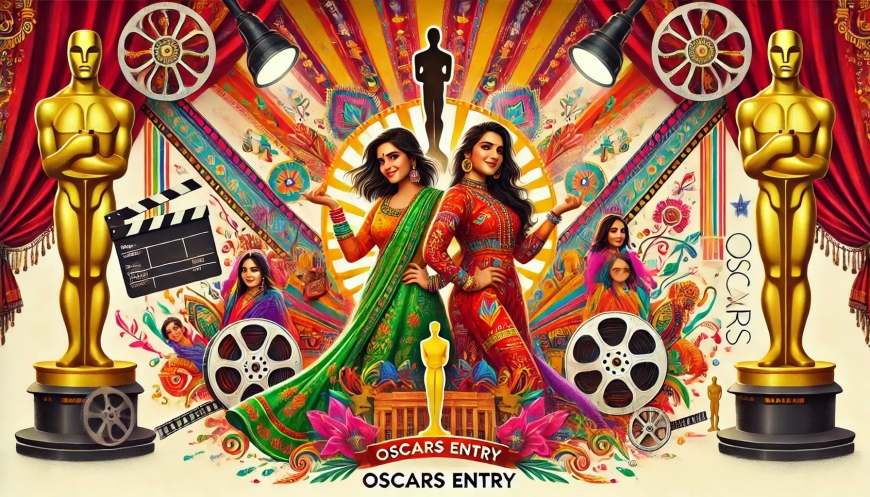Laapataa ladies Oscars: India’s Oscar 2024 Entry | A Bold Story of Women’s Freedom
Discover why Laapataa Ladies, India's official Oscar 2024 entry directed by Kiran Rao, is making waves globally. Explore its powerful themes of gender, identity, and rural life that captivate audiences and critics alike.

Laapataa Ladies: India's Official Entry to the Oscars 2024
Laapataa Ladies, directed by Kiran Rao, has made headlines by being chosen as India's official entry for the Oscars 2024. This announcement has captured attention not only in India but around the world, with cinephiles, critics, and industry insiders expressing curiosity about the film, its theme, and its potential to leave a mark on the global stage. This article delves into the movie’s plot, its cultural and cinematic significance, Kiran Rao’s vision, and the importance of the Oscars entry for Indian cinema. By the end, you will have a detailed understanding of why Laapataa Ladies is more than just a film; it represents a broader social narrative and a step forward for Indian cinema on the international stage.
1. Introduction to Laapataa Ladies
India’s cinematic culture has produced a number of globally recognized films, but the selection of Laapataa Ladies as the official entry for the Oscars 2024 represents a unique moment in Indian cinema. Directed by Kiran Rao, the film has garnered significant attention due to its bold narrative, fresh directorial approach, and strong cultural undertones. Released in India in 2023, the film quickly became a favorite at various film festivals, with its nuanced portrayal of societal issues resonating both at home and abroad.
The word "Laapataa", which means “missing” in Hindi, aptly hints at the core theme of the movie. The story revolves around two newlywed women who go missing in a rural Indian village and the ensuing search that reveals not just their whereabouts but also the intricate dynamics of rural society. With themes of identity, freedom, and gender inequality, Laapataa Ladies offers a poignant commentary on the status of women in rural India, making it a timely and important narrative on both national and global fronts.
The announcement of Laapataa Ladies as India’s official Oscar submission for the Best International Feature Film category was made in September 2023. This marked a significant moment for the film and its team, as it opened doors to the global stage, offering an opportunity to share this unique story with international audiences.
2. The Journey to Becoming India’s Official Oscar Entry
The road to being chosen as India’s official entry to the Oscars is no easy feat. Each year, the Film Federation of India (FFI) convenes a jury of film experts who carefully review and select a film that represents the country in the Best International Feature Film category. For 2024, Laapataa Ladies was chosen from a highly competitive lineup that included films from diverse genres and regional industries across India.
The selection of Laapataa Ladies highlights the growing recognition of socially relevant films within Indian cinema. Films that focus on rural life, women’s struggles, and human relationships often resonate well with international juries because of their universal themes. However, a key reason for its selection also lies in its ability to tell a story that is uniquely Indian while being globally relatable. With increasing emphasis on films that present a fresh narrative voice, Laapataa Ladies was chosen for its bold subject matter, authentic storytelling, and the craftsmanship of its director.
3. Plot Summary of Laapataa Ladies
The film is set in rural India during the mid-1990s, an era characterized by limited communication tools and deeply entrenched social traditions. The central plot revolves around two young brides, Phoolmati and Janki, who go missing shortly after their wedding. What begins as a seemingly simple search for the missing women quickly spirals into a journey that reveals the complexities of their lives, the restrictions placed upon them by tradition, and their personal quests for freedom and identity.
The two women, though united by their shared fate, represent different facets of rural Indian womanhood. Phoolmati, the more outspoken of the two, grapples with her desire to break free from societal expectations, while Janki, quieter and more introspective, embodies the internal struggle between acceptance and resistance. As the search for the women unfolds, the film exposes the patriarchal structures of rural India, the economic hardships faced by families, and the role of community in shaping the lives of women.
Through this exploration, the film touches upon themes such as gender inequality, freedom, and the search for identity. It also delves into the concept of choice, questioning whether the women are truly missing or if they have intentionally disappeared to reclaim their agency. By the film’s end, the audience is left with a powerful message about the often unseen struggles of women in rural societies.
4. Director Kiran Rao’s Vision
Kiran Rao, known for her previous directorial work on Dhobi Ghat, brings her unique artistic sensibility and narrative depth to Laapataa Ladies. Rao has long been celebrated for her ability to present the complexities of human relationships and societal structures through an authentic, grounded lens. Her films often explore urban-rural contrasts and the personal challenges faced by women, making her an ideal director for a story as layered as Laapataa Ladies.
Rao’s decision to set the film in the 1990s, a period of social transition in India, was a deliberate one. The lack of mobile phones and modern communication devices in that era allowed her to focus on the human elements of the story, heightening the sense of isolation felt by the two missing women. Moreover, Rao’s focus on the rural landscape of India serves as a commentary on how geography and isolation often reinforce gender norms and social constraints.
In interviews, Kiran Rao has spoken about how Laapataa Ladies was inspired by real-life stories of women who either disappeared or were presumed missing, but were often simply trying to escape oppressive environments. She has approached the film with a feminist perspective, making the narrative about agency and freedom, not just survival.
5. Cinematic Style and Techniques
One of the most striking aspects of Laapataa Ladies is its cinematic style, which emphasizes realism while also offering moments of poetic visual storytelling. Cinematographer Siddharth Diwan uses wide shots of the rural landscape to emphasize the isolation of the characters, while the close-ups on the women’s faces capture their emotional turmoil and the subtle shifts in their expressions.
The film’s color palette plays a significant role in conveying the mood. The dusty, earth-toned hues reflect the harshness of rural life, while the brighter, more vibrant colors appear in moments of personal revelation or rebellion. The use of natural light enhances the realism of the setting, creating a sense of immersion for the audience.
Music and sound design are also integral to the film’s storytelling. Composer Ram Sampath crafted a soundtrack that incorporates traditional Indian instruments, blending them with more modern, minimalist soundscapes to reflect the tension between tradition and progress. The sound design, too, is subtle but powerful, using ambient sounds—such as the rustling of leaves, the distant calls of villagers, and the crackling of fires—to create a deeply atmospheric experience.
6. The Cultural and Social Themes in Laapataa Ladies
Laapataa Ladies tackles a wide range of social and cultural issues, all of which are central to the lives of women in rural India. One of the key themes is the oppression of women in patriarchal societies. The film highlights how women, particularly in rural areas, are often restricted by societal norms that limit their freedom and control their choices.
The institution of marriage is another central theme in the film. In rural India, marriage is often seen as the only path for women, and once married, they are expected to fulfill their roles as wives and daughters-in-law, with little room for personal aspirations or desires. The disappearance of the two brides is symbolic of their attempt to escape this restrictive life, though the film leaves it ambiguous as to whether they succeed.
The film also explores the dichotomy between tradition and modernity. Set in the 1990s, Laapataa Ladies shows a society caught between the past and the future, with some characters clinging to traditional values while others are eager to embrace change. The missing women represent this conflict, as they are both bound by tradition yet yearn for the possibility of a different life.
7. Representation of Women in Indian Cinema
The representation of women in Indian cinema has evolved significantly over the years. Traditionally, female characters in Bollywood were often relegated to secondary roles, existing only to support the male protagonist. However, in recent years, there has been a shift towards more complex, independent female characters who challenge societal norms and fight for their own agency.
Laapataa Ladies continues this trend by offering a nuanced portrayal of two women who defy expectations and refuse to accept their prescribed roles. Rather than focusing solely on their victimhood, the film emphasizes their strength, resilience, and desire for self-determination. This represents a broader shift in Indian cinema, where more filmmakers are telling stories that center on women’s experiences and challenges in a patriarchal society.
The film also challenges stereotypical portrayals of rural women in Indian films. While rural women are often depicted as passive and subservient, Laapataa Ladies shows them as fully realized characters with their own desires, frustrations, and ambitions. This reflects a more modern, feminist approach to storytelling in Indian cinema.
8. Comparison to Other Indian Oscar Entries
India has a long history of submitting films for the Best International Feature Film category at the Oscars, with varied results. Films like Mother India (1957), Salaam Bombay! (1988), and Lagaan (2001) have received nominations, but no Indian film has yet won the prestigious award.
In comparison to previous Oscar entries, Laapataa Ladies stands out for its focus on women’s issues and its intimate portrayal of rural life. While films like Lagaan and Mother India also dealt with rural themes, they often centered on larger social and political struggles, whereas Laapataa Ladies is a more personal, character-driven story. This focus on individual agency and personal freedom could resonate with international audiences and Oscar voters, who have shown an increasing interest in films that offer fresh perspectives on universal themes.
9. The Importance of the Oscars for Indian Cinema
For Indian cinema, an Oscar nomination—or win—represents more than just prestige. It serves as a gateway to global recognition, allowing Indian filmmakers to reach a broader audience and compete on the world stage. An Oscar nod can significantly boost a film’s visibility, opening up opportunities for international distribution and raising the profile of its cast and crew.
Moreover, the Oscars play a crucial role in promoting cultural exchange. Films like Laapataa Ladies, which offer a glimpse into the lives of women in rural India, can help international audiences understand the diversity and complexity of Indian society. By showcasing films that highlight social issues, the Oscars can also promote awareness of these issues and encourage dialogue around them.
10. International Reception of Laapataa Ladies
The international reception of Laapataa Ladies has been overwhelmingly positive, with critics praising its authentic portrayal of rural life and its strong performances. The film made its debut at several international film festivals, where it was met with critical acclaim and garnered attention from both audiences and industry professionals.
At the Toronto International Film Festival (TIFF), Laapataa Ladies was praised for its compelling storytelling and strong social commentary. Reviewers noted that the film’s exploration of gender roles and societal expectations was both timely and universal, making it accessible to audiences around the world.
Early predictions for the film’s Oscar prospects have been optimistic, with several critics suggesting that its unique narrative and powerful performances could make it a strong contender in the Best International Feature Film category. However, as with any Oscar race, much will depend on the film’s ability to maintain momentum through the awards season.
11. Key Actors and Performances
The cast of Laapataa Ladies features several standout performances that bring the film’s characters to life. The two leading actresses, Phoolmati and Janki, are played by relatively new faces in Indian cinema, but their performances have been widely praised for their depth and authenticity.
Phoolmati, portrayed by Nitanshi Goel, is a bold and outspoken character who challenges the expectations placed upon her by society. Goel’s performance is both raw and nuanced, capturing the internal conflict of a woman who wants more from life but is unsure how to achieve it.
Janki, played by Puja Pandey, is a quieter, more introspective character, but no less compelling. Pandey brings a quiet strength to the role, showing the emotional complexity of a woman torn between her duty to her family and her desire for personal freedom.
The supporting cast also delivers strong performances, particularly in their portrayal of the rural community that both helps and hinders the search for the missing women. The ensemble cast creates a rich tapestry of characters that add depth and dimension to the film’s portrayal of rural life.
12. Production and Behind-the-Scenes Insights
Laapataa Ladies was shot on location in rural India, with the filmmakers working closely with local communities to ensure the authenticity of the film’s setting and characters. The film’s production was marked by several challenges, including the logistical difficulties of shooting in remote locations and the need to accurately represent rural life without resorting to stereotypes.
Director Kiran Rao and her team spent months researching the lives of women in rural India, interviewing villagers and immersing themselves in the local culture to gain a deeper understanding of the issues facing women in these communities. This research informed the film’s script, helping to create a narrative that is both authentic and respectful of the experiences of rural women.
The production team also worked to ensure that the film’s visual style reflected the harsh realities of rural life. Cinematographer Siddharth Diwan used natural light and a muted color palette to create a sense of realism, while the film’s costume and set designers worked to accurately represent the clothing and homes of the film’s characters.
13. Film Festival Circuit: Building Buzz
Laapataa Ladies has made the rounds at several prestigious international film festivals, building buzz and gaining critical acclaim in the lead-up to the Oscars. The film had its world premiere at the Toronto International Film Festival (TIFF), where it was met with rave reviews and became a favorite among festival-goers.
The film also screened at the Venice Film Festival, where it was praised for its strong feminist themes and compelling performances. These festival screenings have helped to raise the profile of Laapataa Ladies and build momentum for its Oscar campaign.
Film festivals play a crucial role in the Oscar race, as they provide a platform for films to gain visibility and generate buzz. For Laapataa Ladies, the positive reception at these festivals has been a key factor in its success, helping to position the film as a serious contender for the Best International Feature Film category.
14. What Makes Laapataa Ladies Oscar-Worthy?
Several factors contribute to Laapataa Ladies being an Oscar-worthy film. First and foremost is its unique narrative, which offers a fresh perspective on gender roles and freedom in rural India. The film’s focus on the personal struggles of two women in a patriarchal society is both timely and relevant, making it a compelling choice for Oscar voters.
The film also boasts strong performances from its cast, particularly the two lead actresses, who bring depth and complexity to their roles. Their portrayals of women caught between societal expectations and personal desires are both moving and thought-provoking.
In addition, Kiran Rao’s direction is a standout aspect of the film. Her ability to tell a personal, intimate story while also addressing broader social issues makes Laapataa Ladies a powerful and impactful film. Rao’s focus on authenticity and realism, combined with her attention to detail, creates a film that feels both specific to its setting and universally relatable.
Finally, the film’s cinematography and sound design are also noteworthy. The use of natural light and ambient sound helps to create an immersive experience for the audience, drawing them into the world of the film and allowing them to fully engage with the characters and their struggles.
15. The Future of Indian Cinema at the Oscars
The selection of Laapataa Ladies as India’s official Oscar entry marks an important moment for Indian cinema. In recent years, there has been a growing recognition of the diversity and quality of films being produced in India, and Laapataa Ladies represents a continuation of this trend.
The film’s success could help pave the way for more Indian films to be recognized on the global stage, particularly those that focus on social issues and offer a fresh perspective on life in India. As Indian cinema continues to evolve and explore new narratives, it is likely that we will see more films like Laapataa Ladies being submitted for international awards.
16. Marketing and Promotions for the Oscars Campaign
For Laapataa Ladies to succeed in the Oscar race, a strong marketing and promotion campaign is essential. This includes screening the film for Oscar voters, hosting Q&A sessions with the filmmakers, and building relationships with key industry players.
The film’s team will also need to focus on promoting the film’s social relevance and universal themes to international audiences. By highlighting the film’s exploration of gender roles and freedom, they can appeal to voters who are looking for films that address important social issues.
However, promoting a non-English film in the Oscars race can be challenging, as it requires overcoming language barriers and cultural differences. To succeed, the film’s team will need to ensure that the film’s unique narrative and cinematic quality are effectively communicated to Oscar voters and international audiences.
17. Frequently Asked Questions (FAQs)
1. What is Laapataa Ladies about?
Laapataa Ladies is about two young brides, Phoolmati and Janki, who go missing in a rural Indian village shortly after their wedding. The film explores themes of gender inequality, freedom, and identity, offering a powerful commentary on the lives of women in rural India.
2. Who directed Laapataa Ladies?
Laapataa Ladies was directed by Kiran Rao, an acclaimed Indian filmmaker known for her previous work on films like Dhobi Ghat. Rao brings her unique artistic vision and narrative depth to the film.
3. Why was Laapataa Ladies chosen as India’s Oscar entry?
Laapataa Ladies was chosen as India’s official entry for the Oscars 2024 due to its unique narrative, social relevance, and strong performances. The film’s focus on gender roles and rural life in India resonated with the selection committee.
4. Has Laapataa Ladies won any awards?
Laapataa Ladies has been praised at several international film festivals, including the Toronto International Film Festival (TIFF) and the Venice Film Festival. While it has not yet won any major awards, it has garnered critical acclaim and is seen as a strong contender for the Oscars.
5. What are the main themes of Laapataa Ladies?
The main themes of Laapataa Ladies include gender inequality, freedom, identity, and the oppression of women in patriarchal societies. The film offers a nuanced portrayal of the struggles faced by women in rural India.
6. What are the prospects of Laapataa Ladies at the Oscars?
While it is difficult to predict the outcome of the Oscars, Laapataa Ladies has received positive reviews from critics and film festivals, making it a strong contender for the Best International Feature Film category.
What's Your Reaction?
































